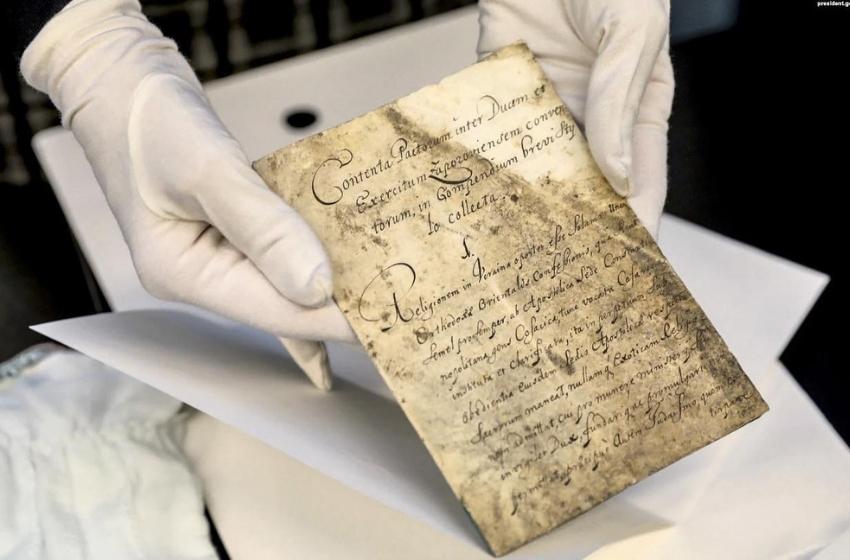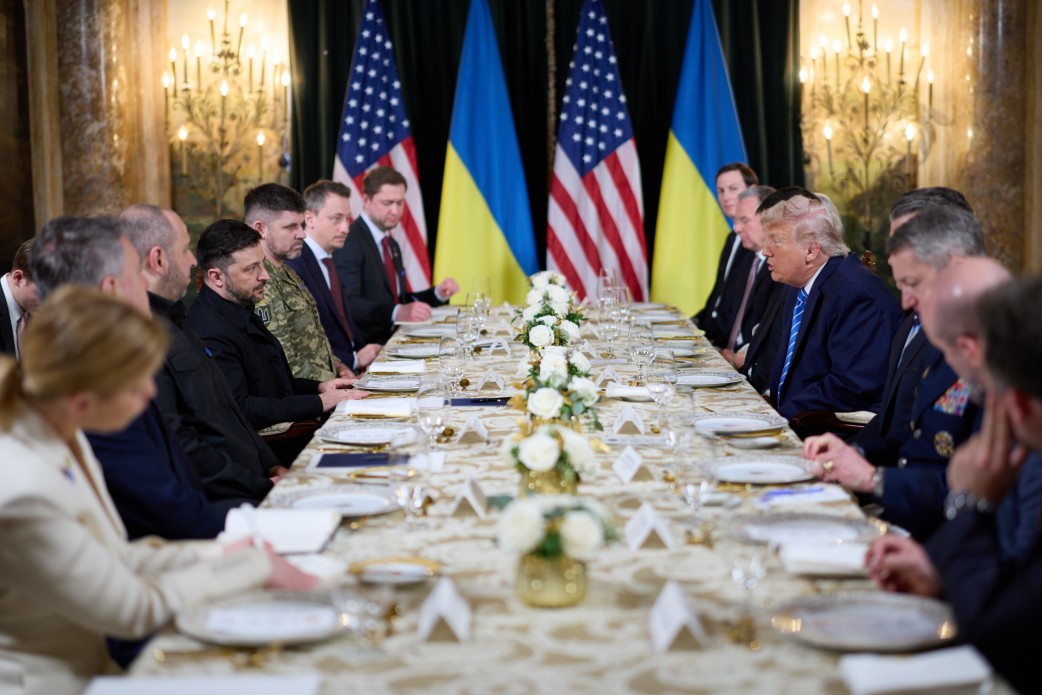This year, Sweden will provide Ukraine with the original Constitution of Philip Orlik (Pylyp Orlyk) of 1710 to celebrate the 30th anniversary of Independence. The manuscript, written in Latin language, can be seen in the National Sanctuary "Sophia of Kyiv".
The original of Pylyp Orlyk's Constitution, which is planned to be brought to Ukraine from Sweden by the Independence Day, will be exhibited in the National Sanctuary "Sofia of Kyiv". In the future, a permanent exhibition with a facsimile copy of this historical document will remain in the historical complex.
The first Ukrainian constitution was adopted at a meeting of the Cossacks near the town of Tyagin on the right bank of the Dniester River on April 5, 1710. The full title of this document is "The Treaty and Establishment of the Rights and Freedoms of the Zaporozhian Army and All Free Russian Little People between the Heavenly Hetman Philip Orlyk and between the Chief Constable, the colonel, and also named the Zaporozhian Army, which by ancient custom and military leadership and fastened by the clearest hetman of the solemn oath.". It is the first in the world to regulate the rights of a vassal and his subordinates. Subsequently, similar documents were adopted in the United States (1787), France and Poland (1791).
Pylyp Orlyk's Constitution never came into force, as it was drafted abroad and its drafters were unable to return to the country. But in history, it has remained an original legal monument, justifying the possibility of a parliamentary democratic republic for the first time in Europe. The Constitution has long been mentioned not only as a memorial of Ukrainian political and legal thought, but also as a memorial of the world political and legal and philosophical thought presented to the civilized world by the Ukrainian cultural elite.
The Constitution consists of a preamble and 16 articles. In the text of the document its authors call the Ukrainian state Ukraine, Little Russia, the Zaporozhye Army. It was, therefore, not merely a philosophical view of a single scholar, but a great normative step towards the incorporation into civilization of the theory of the separation of state power into legislative, executive and judicial through a legal act approved by the constituent assembly of representatives of the Ukrainian Cossacks.

History
After the defeat in the battle of Poltava, Hetman Ivan Mazepa and his closest supporters from among the Cossack officers, together with the remnants of the Ukrainian-Swedish army, found themselves on the territory of the Ottoman Empire, fleeing from the Moscow army. Here, unable to withstand the great upheavals of the year, Ivan Mazepa died. The most probable successor was the general secretary close to the hetman, Philip (Pylyp) Orlyk. When he was elected by the council of elders, a document was adopted defining the rights and responsibilities of the hetman. Since the previous documents of this purpose of the previous elections have not survived, and this document accompanied the election of the hetman for several centuries and was a customary law of the "Country of Cossacks - Ukraine", the Treaty-Constitution of Pylyp Orlyk was officially recognised as the first Cossack, Ukrainian Constitution. It guarantees the supremacy of a Kyiv metropolitan. A large number of the rights of the Cossacks were provided for as well as the protection by the king of Sweden.
Thus, the constitution was adopted on April 5 (16), 1710 at a meeting of the Cossacks near the town of Tyagin on the right bank of the Dniester River (Ottoman name - Bendery, now the territory of Moldova). That is why it is sometimes called the Bendery Constitution.

In 1714 around 40 of the Ukrainians in Moldavia left for exile together with Swedes returning home. The journey across Europe first ended in Stralsund (Swedish Pommerania) in May 1715. Later that year to avoid capture Hetman Orlyk and the Ukrainians (including parts of the government) left Stralsund by ship for Ystad, Sweden. Orlyk and family came to reside in the fortress city of Kristianstad in Southern Sweden 1716 to 1719, while his government continued to Stockholm. During 1719 to 1720, Orlyk joined them in the Swedish capital.
The Ukrainian government-in-exile in Stockholm was supported by the Swedish government of Frederic I and especially by the prominent Swedish politician Daniel von Höpken. The latter aided Orlyk and his ministers financially and most likely with living quarters. In June 1720, von Höpken in a letter advised the king that Orlyk should be financially supported and be given the opportunity to leave Sweden to continue the fight for freedom and independence of Ukraine and lead the Ukrainian Cossacks against Russia. In January 1719, Orlyk had been greatly encouraged by the Treaty of Vienna between Austria, Hannover and Saxony against Russia and its aggressive policy in Eastern Europe.
In a last letter dated Stockholm October 10, 1720, Orlyk wrote in Latin to King Frederic I that when leaving Sweden he first planned to visit the King of Great Britain, then Vienna and after that via Hungary go further East. From Sweden Orlyk first went to Hamburg, Hannover, Prague, Wrocław and Kraków, where he left his family to stay in a monastery.
In foreign policy Orlyk’s best hope was King George I of Great Britain. He was willing to go to war against Russia but in the end could find no partners. British naval squadrons entered the Baltic Sea, from 1719 to 1721, but could not attack Russian ports. The result was that George I advised Frederic I to conclude peace with Peter I on what terms he could. At Nystad in 1721, however, the question of Ukraine’s freedom and independence was not on the agenda of the Swedish negotiators.

Orlyk went on to France and in 1722 he arrived in Yasy in Ottoman Moldavia in order to organize an alliance against Russian Empire. From there he went on to Thessaloniki and from the mid-1730s he is known to have lived in Budjak. He died 1742 in Yasy, Principality of Moldavia (today Romania).
The Ukrainian-language original of the Constitution was found in the Russian State Archive of Ancient Documents by the staff of the Central State Historical Archive of Ukraine, Kyiv, in October 2008. The found set of documents includes the original text of the Constitution, drafted in the Old Ukrainian language, as well as the original confirmatory diploma of Charles XII for the election of Philip Orlyk as hetman. The authenticity of these documents is confirmed by the handwritten signature of Hetman Philip Orlyk and the seal of the Zaporozhian Army on pink wax with a red ribbon, as well as the handwritten signature of Swedish King Carl XII on the diploma and the place where the royal seal was, which, unfortunately, has not survived.
A Latin copy of the 18th century is kept in the Swedish National Archives (Cossack Affairs folder). The document got to the archive after excavations on agricultural lands. He was found in a clay pot rolled up in a scroll. According to Swedish scholars, the document was rewritten by Philip Orlyk for presentation to diplomats of European countries. It was prepared for transportation, but was buried due to certain circumstances. It is this document that we hope to contemplate in "Sophia of Kyiv".

In 2011, a monument dedicated to Pylyp Orlyk was erected in Kristianstad, Sweden on a building Ukrainian hetman lived in 1716–1719 years to celebrate tercentenary of Pylyp Orlyk's constitution. The authors of the monument are Boris Krylov and Oles Sydoruk.





















